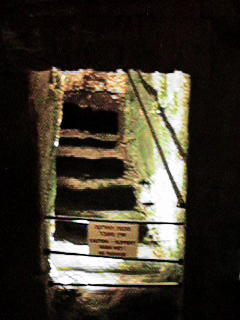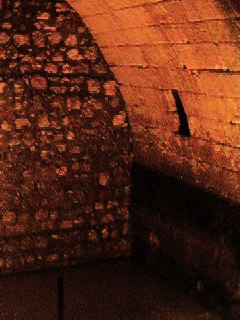
Western Wall Tunnel Tour ©
At the end of the Hasmonean aqueduct we come to a large pool (approximately 171 X 46 feet) which collected rainwater from the northern section of the aqueduct. The pool was called "Struthion," which means "lark," being that it was one of the smaller public pools in Jerusalem during the Herodian period. The pool served as a moat for the northwestern corner of the Antonia Fortress. Prior to the pool's construction, the aqueduct ran from the north into this area servicing the city and the Temple Mount. When Herod expanded the Temple area, he blocked off the southern side of the aqueduct, and the pool was split into two parts. The northern section continued to bring rainwater into the pool, but the southern section no longer had any function.
After the defeat of the Bar Kochba revolt in 135 C.E., the emperor Hadrian turned the entire pool area into a market place. They managed to cover the pool, first dividing it into two with a wall along its length, and then placing two arches fanning out in opposite directions from the walls. On top of these arches they built the square on the platform used for the market.
The pool went through another change in the 19th century. When the foundation for the Convent of the Sisters of Zion was being dug, they discovered the ancient pool and aqueduct. The nuns had another wall built, splitting the pool again, width-wise, to prevent strangers and explorers from entering into their convent through this basement.
The northern side of the aqueduct after the Struthion Pool is not accessible to exploration, being cut off by the convent.
With this we come to the end of the excavations.  The excavators originally
wanted to exit via these steps from the time of Hadrian, but due to political pressures,
this exit had to be abandoned for another accessed by the recently cut
tunnel to the right.
The excavators originally
wanted to exit via these steps from the time of Hadrian, but due to political pressures,
this exit had to be abandoned for another accessed by the recently cut
tunnel to the right.
| Jewish Calendar Date |
TEMPLE
MOUNT TIMELINE |
||
| 2000 | |||
| Binding of Isaac - on Mt. Moriah | |||
| 2500 | |||
| King David buys Mt. Moriah as site for Temple | |||
| King Solomon builds First Temple | |||
| 3000 | |||
| Babylonian destruction | |||
| Zerubabel and Ezra build Second Temple | |||
| Greek oppression | |||
| 3500 | |||
| Chanukah Hasmonean Rule | |||
| 37 BCE: Herod's Reign | |||
| 18 BCE: Herod begins Temple Reconstruction | |||
| 70 CE: Second Temple Destroyed by Titus; Roman Rule of Israel established | |||
| 130
CE: Emperor Hadrian
plows Temple Mount, as prophesied in Micha 3:12. 132 CE: Hadrian forbids Shabbos, circumcision; Jewish people revolt under Bar Kochba. Jews begin rebuilding Temple |
|||
| 4000 | |||
| 333 CE: Traveler from Bordeaux notes that Jews still come to Temple Mount to mourn Destruction | |||
| 550 CE: Emperor Justinian builds churches on Temple Mt | |||
| 691 CE: Caliph Abdul Malik completes Dome of the Rock | |||
| 4500 | |||
| CRUSADERS | |||
| 1099 CE - 1291 CE | |||
| 5000 | |||
| 1264 CE: Mamelukes take Jerusalem, repair Dome of the Rock, Temple Mt | |||
| 1300 CE: Mameluke Sultans of Egypt restore walls of Temple Mt | |||
| 1540 CE: Suleiman the Magnificent sets up present city wall, water tunnels, improves Temple Mt., clears Kotel area | |||
| 5500 | |||
| 1831 CE: Egyptians under Muhamad Ali conquer Jerusalem; forbid repair of Kotel | |||
| 1841 CE: Jewish access to Kotel granted | |||
| 1866 CE: Sir Moses Montefiore renovates Kotel area | |||
| 1889 CE: Ottoman Sultan Abdul Hamid confirms Jews' right to pray at holy places | |||
| British Mandate | |||
| 1948 CE: State of Israel born, Jordanians occupy Old City, Jews barred from Kotel | |||
| 1967 CE: Six-Day War, Old City Reclaimed (Israel liberates Old City amid great rejoicing; Kotel made accessible to all nations) | |||
| 1996 CE: Tunnel Excavations (Kotel Tunnels open exit on Via Dolorosa; Palestinians stage deadly riots throughout country) | |||



